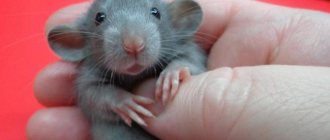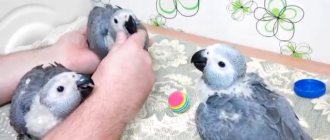Over the next few days you will have to keep an eye on the animal, put it on a tray and don’t forget to encourage it. Thanks to their intelligence, even adult pet rats remember new rules quite quickly. To make the habituation process easier, you can additionally use special sprays for toilet training.
Filler
An important factor is also the filling of the tray. If training is successful, you can use the same material that serves as the main bedding in the cage - for example, sawdust. You can also use a specially designed one - mineral, cellulose or corn. Such fillers are available in the form of granules, which quickly absorb liquid and eliminate the appearance of a strong odor. Accustoming your rat to the tray and using special litter will make caring for the animal quick and easy.
Source
How to train a toilet for rats
Rats are very intelligent creatures, so with a little effort they can be taught to perform certain actions. It’s quite simple to accustom a rat to a litter tray, which will ultimately help you save time on cleaning the cage, as well as money on buying litter, because you will need much less of it.
For training we will need the tray itself. You can purchase a special tray for rodents, but in principle, any suitable container with sufficiently high sides (so that rats do not scatter the filler too much) can serve as its role.
Of course, you will also need filler for the tray. The filler should be chosen to be safe, without pine shavings and sawdust. If the tray has a false bottom, you can also use mineral cat litter.
You can train a rat to use a litter tray at any age, but baby rats usually learn easier and faster.
The entire training method is based on the fact that rats by nature are clean creatures and will go to that place, in our case the tray, where they or other rats have already gone, and where a certain smell remains. The entire training procedure can be divided into several stages:
You need to determine a place, usually a corner in the cage, where your rat usually goes to the toilet. Then you need to place a tray with filler there. Nowadays, stores sell many special corner (and other) trays of different sizes, so purchasing a suitable one will not be a problem. You should add a little used litter to the tray so that the rat becomes accustomed to the smell of the toilet. Now, and this is the most important part, remove all the litter from the rest of the cage. Remember that rats can distinguish between the living area and the toilet area, so fill the tray (corn, paper, etc.), and in the rest of the cage you can use waffle towels, mattresses, special diapers for dogs, etc. as bedding. Finally, you need to show the rats their new toilet. Throw them into the cage and place them directly in the tray so they can sniff around. If the rats start going to the tray, you should praise them and give them something tasty as a reward, but if they go to another place, then they should be systematically transferred to the tray and gradually they will understand what you want from them.
As a rule, this method is effective, but it may happen that the rats will not always go to the tray in a small way, especially the males, because they mark their territory. You may also come across a rather stubborn rat that will show its character and refuse to go into the litter box on principle. In this case, be patient and persistent.
The presence of a tray in the cage, as already mentioned, will simplify the cleaning process, because it is much easier to replace the filler in a small tray than in the entire cage, and besides, this can be done as it gets dirty (more often or less often).
A significant advantage in favor of the tray is the fact that the rats will not be in constant contact with the filler. And if you use towels, mattresses or something else as bedding in the rest of the cage, then the rats will feel very comfortable, because this will reduce the presence of possible dust from the filler to zero, and the rat’s paws will always be soft. In addition, in this case there will be less garbage around the cage because the rats will have nothing to scatter.
In the future, during walks, you will need to return the rats to the cage from time to time and put them in the tray so that they understand that they need to go there to the toilet.
Source
Step-by-step instruction
Time to move on to the basic instructions, by following which you can teach your kitten a new, very useful habit - going to the toilet in the tray.
Place the litter in a quiet and secluded area of your home. This should not be a passage or corridor, or areas near doors where people often walk. The ideal place is a bathroom or toilet, which is always open and the cat has access to the litter around the clock. The best time for the first trip to the new toilet will be 20-40 minutes after the kitten eats. Take it and place it with its paws directly into the tray with the filler. Pet him, say something kind, and then move away and let him look around and sniff the new place. If the kitten is ready, it will do all the necessary things. After the procedure is completely completed, praise him and cover the waste with a fresh layer of filler.
Disposal of waste should not be done due to the importance of the smell of waste in the toilet area. Cats smell this smell and it’s easier for them to find a place to go to the toilet.
However, you cannot leave the toilet completely untouched. Kittens and adult cats are very picky about cleanliness and will not go into a dirty litter box.
If the cat went past the toilet more than an hour ago, do not scold him, this will cause him misunderstanding. He won't remember what he did wrong. It is necessary to make it clear in a timely manner about the mistake made, but as we wrote above, do this in an extremely friendly manner - without shouting or physical violence.
How to litter train a rat
Rats are very intelligent animals and can be taught to perform a wide variety of tricks and commands. Therefore, these rodents are easy to train to the tray. This will save a lot of time when it comes to cleaning the cage because it won't have to be done as often. This also saves additional money, since contaminated litter will also not need to be changed every day.
Are pet rats incontinent?
No, pet rats are not incontinent. Many people believe that pet rats are incontinent and cannot control their bladder because they urinate frequently. The reason they urinate on things is because they mark the object (or person) they are urinating on as their territory or part of their group, not because they cannot control their bladder.
Rats actually have very good bladder control. They are very picky about where they pee and are relatively easy to potty train. If you want to train your rat to urinate in a specific area, the best way to do this is to put a litter box in the cage filled with a different substrate than what they have in the cage.
Potty training your rat is not that difficult and is a good way to make cleaning the cage easier.
Training equipment
The first thing you will need is one or more trays. The number depends on the size of your cage and the places where rats like to go to the toilet.
However, you don't necessarily need to buy specially made trays from stores - old, clean cardboard boxes cut to size will do, although they will need to be replaced regularly. Plastic food containers will also work for this purpose.
You also need a suitable filler. This should be different from the substrate used on the cage floor and in digging boxes, as rats only need to associate it with the litter box.
Possible problems
Sometimes, despite long walks, the puppy will continue to relieve itself at home. Moreover, in some cases, he may at that moment look into the owner’s eyes, and then sincerely not understand why he is being scolded. How to teach a husky to go to the toilet in this case? The most important thing is not to lose a trusting relationship with the dog, which will not be easy to regain.
You need to try to understand why the baby is not happy with the outdoor toilet. Perhaps the puppy does not get enough walks or is distracted by other dogs. There is no need to yell at the puppy; this will not teach him correct behavior. The owner should be calm and friendly, the puppy should not be afraid of him. In the most advanced cases, the help of an animal psychologist may be required.
Rat litter
Keep in mind that even the best litter needs to be changed regularly. It is recommended to change the litter in the tray once a day - yes, this is extra work, but your pet will thank you.
The best types of fillers:
- Paper pellet litter:
Paper pellets (such as Carefresh ) are an ideal choice for rats as they absorb moisture and are fairly inexpensive. They quickly become soft when they get wet. Therefore, it is worth changing it quite often if you do not want your room to acquire an unpleasant odor.
- Straw pellet bedding:
- Shredded cardboard litter:
This type of bedding is good for rats because, like paper pellets and straw litter, cardboard has no harmful properties. - Cloth Bedding
: Some people choose to place cloth in the rat's litter box and clean it daily. This option is suitable if your rat is allergic to other types of litter. However, it is important that the fabric is in good condition. Such material can cause injury if it accidentally wraps around a rat's paws or tail.
straw litter works the same as paper litter. This type of litter is also good for rats because it is non-toxic and has excellent absorbent properties.
Tail movements
One of the main indicators of a rat’s mood is the “behavior” of its tail. An attentive observer will be able to accurately determine the emotional state of his pet if he pays attention to the longest part of his body.
Table 2. How to decipher rat tail movements.
Nature of movementWhat does it mean?
| Lightly swings left and right | The rat is in good spirits, glad to see the owner |
| The tail twitches or freezes in a static position, often quite unnatural | Anxiety, defensiveness |
| Swings in both directions, range of motion is quite large | The animal is stressed and very scared. Perhaps the animal is in an inadequate condition |
The behavior of rats in the search mode differs significantly from their behavior in a calm state. At the same time, sick animals can be distinguished by slow movements and a “lifeless” tail dragging along the floor.
A healthy rat is usually very curious. She enjoys exploring her surroundings. If a rodent is interested in something, it usually rises on its hind legs and sucks in air through its nose. The rat's tail is slightly tense and sometimes motionless.
The animal can enthusiastically turn its head while searching for an interesting object. In this state, the rat turns on all external analyzers, examines visible objects, sounds, and smells.
Methods for training a rat to use a litter tray
You can train a rat to go to the toilet in a certain place by following the following algorithm:
Step 1:
Find a plastic or cardboard container that can serve as a rat litter tray. Pet stores and pet supply websites now sell trays designed for small rodents. Save money by using a shallow plastic food storage container or an old bowl that will serve the same purpose.
Step 2:
fill the new litter box with new litter, rat droppings and dirty litter. Rat droppings will help the rat understand that this is where it should go to the toilet.
Step 3:
Place the tray in the corner of the cage where the rat most often relieves himself. Most rats are very clean and prefer to only use one area to keep the rest of the cage clean and free of dirt. This makes it very easy to litter box train a rat as they are very tidy animals.
Step 4:
Clean the cage the same day the litter tray is installed in the rat cage. This will rid the space of all previous waste and help the rat understand that only the corner with the tray should be used for elimination.
Step 5:
Place your rat in a special litter tray so he knows it's there. This is especially important if the rat has a very large cage or a cage with several levels. The rat needs to be shown the location of the litter tray; quite possibly many times, especially if the rat does not immediately use the litter tray.
Step 6:
On the first day, check your rat every few hours to make sure it has used the litter box. If you find droppings outside the litter box, simply place the rat and its droppings in the litter box and say, “No!” If you notice your rat using the litter box, reward your pet with his favorite treat.
What to do if a rat sleeps or eats in a tray
Don't worry, it happens. It is important to remember that rats do not have human concepts of rooms and hygiene. Yes, they are quite clean animals, they have toilet corners, and in the wild they clean their burrows of dirt. But pooping and peeing still have different meanings for them.
A rat may sleep in a litter tray just because it is convenient for him. Food is often eaten and stored in litter trays because they smell - they mark the territory and food as theirs. And yes, sometimes rats do eat their own waste. This is their way of recycling nutrients.
Why do rats pee everywhere?
Do rats have a bladder? It's no secret that rats urinate everywhere. If you've had a pet rat for any length of time, I'm sure you're familiar with this behavior. Many people don't understand why they do this. Perhaps they are marking their territory, or perhaps because they do not have a bladder and therefore cannot control it?
The short answer to the question of whether rats have a bladder is this: Because rats urinate a lot, they are often thought to have no bladder. This is not true - it definitely is. They just pee a lot because they use their urine as a way to communicate with their fellow rats. For example, they may use it to mark their territory or even to identify other rats.
Adviсe
- Separate the litter box in the cage as far away from the sleeping area as possible.
- Clean your rat's litter box at least once a week. Change the litter in the toilet once a week. Refill the litter box with fresh litter as soon as you place him back in the cage. Be sure to clean the bedding weekly to keep your cage odor-free.
- If there is even the slightest odor coming from the litter box, change the litter. Rats have a very sensitive respiratory system, and the smell of ammonia coming from the litter box can cause pneumonia in a rat.
- While you are training your rat, leave some dirty litter or droppings in the litter box so they know where it is.
- Reward your rat with a treat when he uses the litter box to reinforce good behavior. When you notice your rat going about his business in the litter box, praise him in a cheerful voice before giving him a small treat. During the first 2-3 weeks of training, give your rat a treat every time he enters this area of the cage.
- Clean up all droppings outside the litter box at all times. If you see droppings anywhere else in the cage, immediately pick them up and place them in the litter box. Make sure there is no rat waste anywhere, otherwise the training will not be as effective.
There are many benefits to toilet training. This makes the cage much cleaner, reduces odor and means you no longer have to clean the cage as often. If you allow your rat to play outside its cage for a bit, such as in a rat play area, it can also be trained to use the litter box outside the cage. Place the litter box in the same corner of the play area as the cage. If she needs a toilet break while playing, the rat can simply go to the litter box.
Source
Moustache wiggling
Rat whiskers are sensitive antennas that help animals navigate in space. The information that rodents receive with the help of such a navigator is so detailed that the animals not only move confidently in the dark, but also receive an almost complete understanding of the surrounding objects, including the features of their dynamic trajectory.
When a rat moves its whiskers, it not only explores odors, collects information about the world around it, but also maintains the balance of movement. It is with its sensitive whiskers that the animal first of all checks unfamiliar objects, including the palms of people.
Training equipment
The first thing you will need is one or more trays. The number depends on the size of your cage and the places where rats like to go to the toilet.
However, you don't necessarily need to buy specially made trays from stores - old, clean cardboard boxes cut to size will do, although they will need to be replaced regularly. Plastic food containers will also work for this purpose.
You also need a suitable filler. This should be different from the substrate used on the cage floor and in digging boxes, as rats only need to associate it with the litter box.
Where to put the tray to quickly train a kitten?
The tray is placed in a remote area from the kitten’s feeding area so that the smells do not mix. It is better to choose a corridor, balcony, toilet or bathroom for the cat litter, it depends on the interior and the desires of the owner.
Be sure to read:
The cat cannot go to the toilet in a small way, what to do at home: first aid
It should be easy for the animal to reach the tray at any time of the day without assistance, so it is better to choose a room where there are no doors or where they are easy to open.
You need to immediately determine the only place for the cat’s toilet; you should not rearrange it, as this will negatively affect the kitten’s training in the litter box.
The danger of urban rats
Rats are carriers of more than a hundred different types of diseases, which can even be present in one carrier at the same time. Rat bites can be fatal to humans, and a rat, if it senses any threat to its life, will certainly bite the source of this threat.
The worst thing is that rats have an increased level of socialization, thanks to which they can perfectly communicate with each other and transmit any information. Therefore, if one individual was able to find a way into the apartment through the sewer, after some time the entire population will know about it and use the new path.
No matter how fantastic and crazy the idea that a rat can get into your home through sewer pipes may seem, it is still true. So try to protect yourself. Install special screens where the toilet is attached to the pipes, do not flush food or leave it in the toilet, such as a bowl of pet food.
However, if a rodent does appear, it must be caught and thrown away immediately. The first rat to appear in your toilet is just a scout . The rest will begin to come after her, if she can return and pass everything on to her relatives. In addition, if you didn’t notice the first discoverers, the next ones will be able to calmly get out of the toilet and wipe the wet skins on towels, rugs and carpets, leaving a lot of harmful bacteria on the fabric.
Do rats communicate through urine?
It may seem strange (and a little gross), but rats can communicate with each other through urine. Did you know that rats can learn information about other rats, such as age, species, gender, reproductive status, testosterone levels and more, through urine? This is quite remarkable.
They also often mark each other with urine. Female rats are known to mark males they like with their urine. They usually do this before estrus. It is assumed that they do this so they know which males they would like to reproduce before they go into heat.
On the other side of the spectrum, males also mark females. It is believed that they do this without notifying the female that they are available for mating.
Rat litter
Keep in mind that even the best litter needs to be changed regularly. It is recommended to change the litter in the tray once a day - yes, this is extra work, but your pet will thank you.
The best types of fillers:
- Paper pellet litter:
Paper pellets (such as Carefresh) are an ideal choice for rats as they absorb moisture and are fairly inexpensive. They quickly become soft when they get wet. Therefore, it is worth changing it quite often if you do not want your room to acquire an unpleasant odor.
- Straw pellet litter:
Straw litter works the same as paper litter. This type of litter is also good for rats because it is non-toxic and has excellent absorbent properties. - Shredded cardboard litter:
This type of bedding is good for rats because, like paper pellets and straw litter, cardboard has no harmful properties. - Cloth Bedding
: Some people choose to place cloth in the rat's litter box and clean it daily. This option is suitable if your rat is allergic to other types of litter. However, it is important that the fabric is in good condition. Such material can cause injury if it accidentally wraps around a rat's paws or tail.
However, the following types of fillers should definitely be avoided:
- Cedar and pine litter:
These types of litter should never be used for rat litter because they are extremely toxic. Both of these types of bedding smell great, but produce toxic fumes that can make your rats very sick.
- Cat Litter
: Cat litter, especially lumpy cat litter, can form clumps in a rat's stomach and make them very sick. Also, such bedding often generates copious dust, which is harmful to the respiratory system of rodents. Although, as a last resort, you can choose a natural, non-clumping cat litter. But this is still far from the best choice for a rat. - Cedar Litter:
Another type of litter that is virtually useless for almost any animal. Corn cob litter can cause problems if ingested and tends to become moldy.
Breeds of decorative rats
Let's take a look at the main varieties of pet rats to make it easier for you to choose. Decorative rats are divided into:
Division by body type
rats . The name was given because of its resemblance to Disney's baby elephant Dumbo, who could fly by waving his huge ears. Dumbo the rat's ears aren't that big, but they stand out. Rounded, sticking out more to the sides than to the top, like the others.
What are you watching? Quite an average size!
Standard . There’s nothing even to add to the name of the breed – a standard rat.
Standard? Sounds like an insult.
Tailless . An ordinary house rat, but without a tail.
Classification by coat type
Rex . Pets with beautiful curls.
Rex.
Satin (Satin, Longhair) . Thin, soft fur, which, when properly cared for, shimmers in the rays of light.
Satin Dumbo.
Sphinx (hairless) . Has a little “vegetation” on the head and back. An excellent choice for those who are allergic to wool.
Sphinx Dumbo. Well, aren't I adorable?
Downy (Fuzz) . They are distinguished by short and fine downy fur.
Down jacket.
Types of colors
Nowadays it is difficult to find a color that has not yet been developed by breeders. But there are also those that stand out from the general background.
Blue domestic rat. A very interesting shade of fur that needs to be seen in person (not every screen captures this color correctly).
Husky . The coloring is similar to that of dogs of the same breed.
Decorative white rat. People often look for a white rat with red eyes. The eyes are red because blood vessels are visible through them (in albino rats, not only the fur is discolored, but also the eye pigment).
Selection of container and filler
You can make a toilet yourself; all you need to do is take a pallet with low sides. The product should be made of plastic or ceramic - this material does not absorb odors, and is also quite easy to wash. Pet stores sell special trays for rodents; they are easy to place in the cage.
Important! Rodents are good at distinguishing the living area from the toilet, focusing on smells. Therefore, before installing a sanitary container, you should thoroughly rinse the entire cage so that there are no third-party fragrances.
They exist in two types:
- Open . Without top cover.
- Closed . With lid.
As a filler, you can use special granules: mineral, cellulose, which absorb moisture and unpleasant odors. Wood filler is also used, which is suitable for the entire space of the cage.
Bites
Experienced breeders of decorative rodents know that you need to thoroughly wash your hands when interacting with animals. Rats are unusually sensitive to odors. They may mistake a hand that smells like food for the food itself and grab it tightly with their teeth.
If an animal slightly bites its owner, ruffles its hair, and quietly clicks, it means that the animal is in a good-natured mood and invites you to play. A rat that has adopted an aggressive posture may bite for real if you do not give it time to recover.
When a fight brews in a cage, bites are also inevitable. Therefore, when handling an animal that is experiencing stress, you need to wear thick gloves.
Methods for training a rat to use a litter tray
You can train a rat to go to the toilet in a certain place by following the following algorithm:
Find a plastic or cardboard container that can serve as a rat litter tray. Pet stores and pet supply websites now sell trays designed for small rodents. Save money by using a shallow plastic food storage container or an old bowl that will serve the same purpose.
fill the new litter box with new litter, rat droppings and dirty litter. Rat droppings will help the rat understand that this is where it should go to the toilet.
Place the tray in the corner of the cage where the rat most often relieves himself. Most rats are very clean and prefer to only use one area to keep the rest of the cage clean and free of dirt. This makes it very easy to litter box train a rat as they are very tidy animals.
Clean the cage the same day the litter tray is installed in the rat cage. This will rid the space of all previous waste and help the rat understand that only the corner with the tray should be used for elimination.
Place your rat in a special litter tray so he knows it's there. This is especially important if the rat has a very large cage or a cage with several levels. The rat needs to be shown the location of the litter tray; quite possibly many times, especially if the rat does not immediately use the litter tray.
On the first day, check your rat every few hours to make sure it has used the litter box. If you find droppings outside the litter box, simply place the rat and its droppings in the litter box and say, “No!” If you notice your rat using the litter box, reward your pet with his favorite treat.
Choosing a location to install the tray
Before installing the tray in the cage, you need to choose a suitable location. To do this, you will need to carefully monitor your pets for several days. Namely, pay attention to where they relieve themselves. Almost every rat has a favorite place to go to the toilet. Next you will need to perform several sequential steps:
You should only touch rat feces while wearing rubber gloves. After the procedure, you will need to wash your hands thoroughly with soap.
If your pets go to the toilet erratically and you cannot find suitable places to install the tray, you will need to do the following:
Since the filler will only be in the toilet container, the animals will have no choice but to use the offered “conveniences”. When the fluffies get used to the trays, you can pour the usual filler into the tray.
How to toilet train a rat
Most decorative rats independently choose their own place to relieve themselves. The owners can only install a tray made of easily washable material there and change the filler in a timely manner. But even if your pet constantly changes the place of the toilet, it can be trained to use the tray.
Selecting and installing a tray in a cage
Pet stores offer a wide selection of rat trays. They can be open or closed, of various sizes and configurations. However, you can easily make a rat toilet with your own hands from a suitable plastic container.
Some owners prefer to install ceramic trays, but they are harder to secure in place than their plastic counterparts.
Important! The toilet container should not have cracks, chips or scratches in which dirt can accumulate and pathogenic microorganisms can develop. Also, the plastic should not emit an unpleasant “synthetic” smell.
If several rats live in one cage, then each of them needs to be equipped with its own toilet.
Before installing the tray, wash the cage thoroughly. It is best to use laundry soap that does not contain fragrances or toxic components for disinfection and odor removal.
Toilet training your pet
Before organizing a toilet for a rat, you need to remove all the old litter from the cage and replace it with napkins. Next, you should fill the tray with specialized mineral or cellulose granules that absorb liquid and odors well.
Acquiring a skill
In order for your pet to correctly understand the purpose of the container, it is necessary to place a little used litter or droppings in the tray. To make training easier, you can purchase special sprays at pet stores.
When a rat is released into the cage, you need to immediately direct it to the tray. During the first days, you can force your pet to sit in the tray and encourage each “fruitful” trip to the toilet with affection or a treat.
Promotion
Rats very quickly understand the connection between going to the litter box and getting a treat. And if you suddenly stop encouraging your pets, they easily break this chain, then the whole training process will need to start all over again.
To avoid such a “protest”, you should gradually reduce the frequency of treats and strokes, but not give them up completely.
Impact on behavior
Adults have a harder time getting used to the toilet than young ones. Therefore, you should be patient and place your pets on the tray several times a day. You cannot express your dissatisfaction by screaming, as the rat will not make the connection, and a loud, sharp sound will greatly frighten it.
Important! The use of physical methods of punishment is strictly prohibited.
Owners should clearly remember that only patience and affection will give the expected results.
Cleanliness support
To help your rat quickly understand the difference between the toilet and the “living” area, you should regularly remove wet litter and feces. It is advisable to do this several times a day, and before going to bed, wash the container with an antibacterial agent.
Training - Basics
If a kitten is only a month old, then at that age it is extremely rare to train it to go to a litter tray without litter.
Veterinarians advise starting the training process with a toilet, which will have something with which the animal can cover its excrement.
The filler can be either pressed wood shavings or mineral lumps of clay, or ordinary newspaper, torn into small fragments.
It is better, of course, to use a tray with a professional filler that can absorb unpleasant odors and liquid feces
Thus, you can quickly accustom any kitten to the tray, street, Scottish or British, it doesn’t matter, the main thing is that its paws and fur will always be clean and dry.
So, the baby is a month old or 1.5 months old, we purchased a tray, found a place for it, now we move directly to the main process.
- Place the tray with the filler in the selected location.
- We carefully lift the kitten and put it in the vessel.
- We take his paws in our hands and begin to make raking movements.
- Let's release the baby.
Don't expect him to do his business in the new toilet the first time.
It often takes several days, and sometimes a couple of weeks, to train one-month-old kittens to use the litter box.
At first, you need to watch your pet and try to catch his desire to go to the toilet.
When a kitten is 1.5 months old, before defecating, it may show some concern: the animal will seem somewhat alarmed, and may spin in place or rake its paws on the floor.
It’s important not to miss the moment when the kitten starts to shit.
Transfer the animal to the litter tray and wait for the baby to do its job
If an outdoor kitten appears in your apartment, then training it to a litter box will be much faster than, for example, an Egyptian Mau or a Burmese cat.
This is due to the fact that an animal that previously lived in street conditions is much more willing to respond to care and at the same time is very smart.
How long will it take in this case? Usually two or three days, no more.
The length of toilet training for your pet may depend on the quality of the litter.
At what age should a kitten be accustomed to a litter box without litter?
You can do this right away, but it is better after he gets used to his toilet and will always defecate exclusively in it.
To consolidate the result, the kitten needs not a month, but much more: about six months must pass for the animal to fully understand where its latrine is, and only after that can one begin to accustom the kitten to a toilet in which there will no longer be litter.
Reasons for the appearance of rodents in sewers and toilets
Rats decide to live in the same house with you not because it is more convenient and comfortable for them, but because they are forced to look for new places with affordable food and a place to raise offspring . However, these are not the only reasons why rodents decide to move closer to humans. The most common ones are presented below:
- The more actively a rat breeds in the basement, the higher the likelihood that it will soon begin to look for a new place to live, since the old one is filled with its relatives;
- Although rats can tolerate various temperature changes, at the first frost they still try to move to where it will be warmer. In late autumn and winter, rodents increasingly begin to climb into apartments and houses;
- If pest control has recently been carried out in the basement or at a nearby landfill, then be prepared for the fact that entire populations of rats will soon appear in your house, running away from deadly poison.
If the house is old, then it will not be difficult for a rat to gnaw holes in the pipes right in the basement and climb into the apartments. Walls won't stop her either, as a rat's teeth can make a hole in anything. We wrote a separate article about this.
If the house is new, recently rebuilt and made of good and expensive materials, then it will be more difficult for rats to infest it. However, now modern plumbing increasingly consists of ordinary plastic pipes instead of cast iron pipes, which are unlikely to withstand the teeth of rats.
Plastic sewer pipes in the basement are quite vulnerable to rats' teeth
Is this possible?
A rat jumping out of a toilet is not a horror story or a fairy tale, but a fairly common occurrence in everyday life. Rats are known to have excellent intelligence, so they are able to guess that a sewer pipe will help them get to a person and settle into his home.
In this way, a wild rat gets into the house most often from residents of the first and second floors , but there are cases when these smart rodents climbed even higher, to the fifth floor. But you ask: “How can rats move through the sewer and not suffocate in the water?” The answer is simple: rats, like all small rodents, can stay at depth for a long time, hold their breath and swim calmly. In apartment buildings, the sewer system is a network of pipes that connect the apartments. A rat can get into them through the basement, swim a little underwater, and then calmly climb up the vertical pipes.
Rats feel safe in the sewer, but in search of food and warmth they can leave it in any way.
Adviсe
- Separate the litter box in the cage as far away from the sleeping area as possible.
- Clean your rat's litter box at least once a week. Change the litter in the toilet once a week. Refill the litter box with fresh litter as soon as you place him back in the cage. Be sure to clean the bedding weekly to keep your cage odor-free.
- If there is even the slightest odor coming from the litter box, change the litter. Rats have a very sensitive respiratory system, and the smell of ammonia coming from the litter box can cause pneumonia in a rat.
- While you are training your rat, leave some dirty litter or droppings in the litter box so they know where it is.
- Reward your rat with a treat when he uses the litter box to reinforce good behavior. When you notice your rat going about his business in the litter box, praise him in a cheerful voice before giving him a small treat. During the first 2-3 weeks of training, give your rat a treat every time he enters this area of the cage.
- Clean up all droppings outside the litter box at all times. If you see droppings anywhere else in the cage, immediately pick them up and place them in the litter box. Make sure there is no rat waste anywhere, otherwise the training will not be as effective.
There are many benefits to toilet training. This makes the cage much cleaner, reduces odor and means you no longer have to clean the cage as often. If you allow your rat to play outside its cage for a bit, such as in a rat play area, it can also be trained to use the litter box outside the cage. Place the litter box in the same corner of the play area as the cage. If she needs a toilet break while playing, the rat can simply go to the litter box.
Toilet training methods
To teach a rodent to go to the litter box, the animal should be encouraged. This will allow your pet to understand that he is performing the actions correctly. To do this, after each successful time, give the animal his favorite tasty food. Various fruits can serve as treats: apples, pears, bananas. Vegetables: carrots, pumpkin or cucumber. Berries: grapes, raspberries, blackberries or strawberries.
Did you know? The average heart rate of a rodent is about 300–500 beats per minute, which is 240–410 beats more than that of an adult.
To speed up the training process, you should mix a little litter that contains animal excrement with fresh litter. This mixture should be placed in a tray and the container should be placed in the rodent's cage. You should also direct your rat to the toilet immediately after placing him in the cage.
You can purchase a special spray at the pet store that will make it easier to accustom your rodent to the tray.
Training errors
If your kitten does not go to the toilet, this may happen for the following reasons:
- The tray is not convenient enough.
- The animal was scared in the place where the tray was installed.
- The kitten was taken too early, and the mother cat did not have time to teach her to go to the litter box on her own.
- The animal has health problems, so it does not have time to reach the place.
If a kitten does not go to the toilet, this problem must be corrected as quickly as possible: the main character traits are formed in childhood, and it will be more difficult to retrain later. The owner must be persistent, but at the same time gentle, so as not to scare the small pet.











